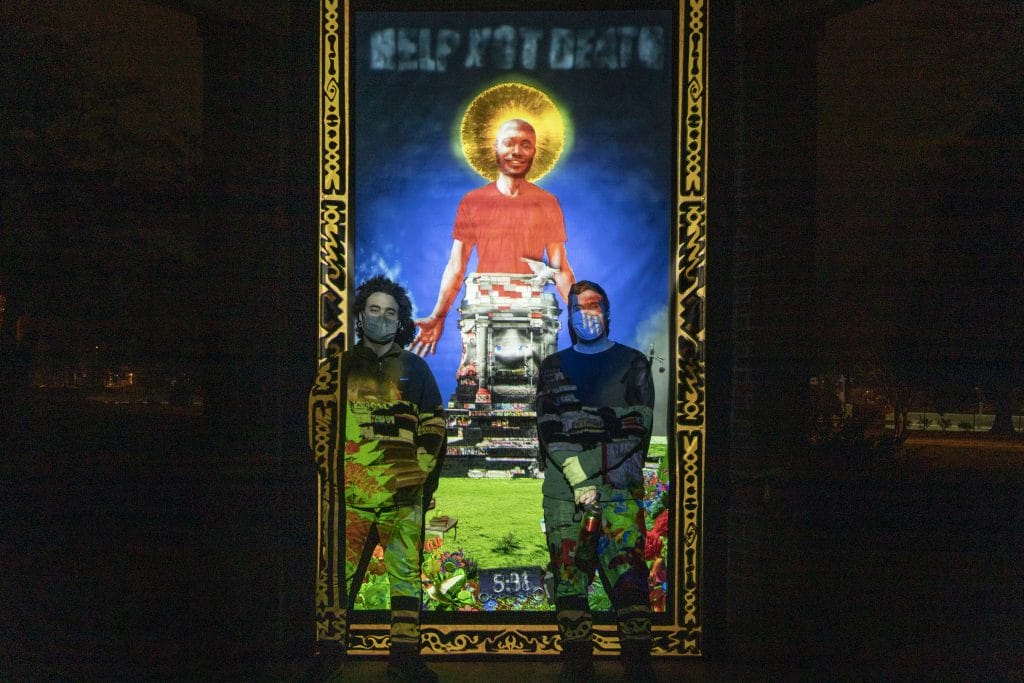Projection art reflects on summer of BLM protests, honors Marcus-David Peters

From left: Painter Miguel Carter-Fisher and projection artist Alex Criqui stand beside their multimodal project, “Marcus-David Peters Circle.” They are two of the five artists that collaborated on the project. Photo by Enza Marcy
Iman Mekonen, Spectrum Editor
An 11-foot-tall vinyl display with muted pastel colors displays a familiar scene of Marcus-David Peters Circle. The grassy area around the base of Robert E. Lee’s statue is filled with references to recent Black Lives Matter protests in Richmond: clouds of tear gas, a burning police car and a basketball hoop.
Artists Alex Criqui and Dustin Klein made one significant change to the iconic landmark — the bronze statue of the Confederate general is absent, and instead, a towering image of Peters emerges from the stone base. The work, titled “Marcus-David Peters Circle” honors the 24-year-old VCU alumnus, who was shot and killed by a Richmond police officer in 2018 while experiencing a mental health crisis.
“We wanted to just almost go over the top with trying to show his life had value,” Criqui said. “He was a special person. He helped people.”
At night, the images come to life as the artwork is complemented by a moving projection of vibrant colors, evolving and changing by the second. The words “Help Not Death” appear in translucent, smoke-like text.

The project was part of 1708 Gallery’s 13th annual Inlight event, a public exhibition of contemporary light-based artwork with multiple sites across the city. The gallery held an open call for submissions, and work was on display at the Randolph Community Center from Nov. 11-15.
Since June, Criqui and Klein have projected various images referencing social justice onto the base of the Lee monument, including photographs of abolitionist Harriet Tubman and Black soldiers serving in the Union Army.
“I feel like so much of what we’ve done at the monument is because of what we’re doing it on,” Criqui said. “That creates all the meaning, using the racial symbols’ power against itself.”
The artists’ latest project was inspired by the story and spirit of the space.
“It seemed like a natural thing to do in terms of like, continuing what we’ve done this summer,” Criqui said. “Let’s see how far we can take light-based art and do something, hopefully a little innovative and creative.”
Throughout the planning process, the artists consulted Peters’ sister, Princess Blanding, regarding the representation of her brother in the painting.
“We just want to make sure if we’re gonna put all this effort and energy into it, it’d be something that she would like because that’s the most important thing,” Criqui said.
In 2018, Blanding created Justice and Reformation, a movement of community members advocating for accountability regarding her brother’s killing.
Peters’ family and community activists have advocated for the Marcus alert system, which would establish protocols for law enforcement officers responding to mental health crises. A special session bill enacting the system was signed into law by Gov. Ralph Northam on Nov. 5, and the law will go into effect on March 1.
The “Marcus-David Peters Circle” animation plays on a loop of 8 minutes and 46 seconds, referencing the death of George Floyd, a Black man who was killed in Minneapolis police custody. Officer Derek Chauvin knelt on Floyd’s neck for that duration of time.
Musician Beth Almore painted a sign that reads “8:46” and resides at the monument. Almore, who often performed her cello at the monument, utilized the sign in performances and left it near a memorial for Floyd. Her sign is depicted at the center of the painting, as an animated timer, counting down from 8:46.
The multimodal artwork combines photography, oil painting, digital painting, computer animation and projections created by a team of artists — Criqui, Klein, Miguel Carter-Fisher, Josh Zarambo and Zach Fichter.
Criqui created the overall design of the project while Klein worked on the animation. Zarambo and Carter-Fisher lent their oil painting skills to the project while Fichter’s photographs were used as inspiration.

They partnered with Carter-Fisher, a former VCUarts adjunct professor, for his interest in portraiture and the human condition in art. He said there was a lot of work leading up to the finished product, despite the painting itself taking two or three days. The vibrant colors included in the painting were a conscious choice that focused on optimism.
“I wanted to stay positive without trivializing the gravity of the tragedy — which is kind of a different, difficult line to walk,” Carter-Fisher said.
Carter-Fisher said the involvement of activism within art is necessary, especially for a community to come together and enact change. He also said art can serve as a reminder to people of the pain that communities experience.
“Art is a vehicle for empathy,” Carter-Fisher said. “You sort of create something outside of yourself, from which people can meet on a level of common experience.”
The painting includes other small details, such as a piano and a green apple representing Peters’ love for music and his career as a high school biology teacher.
The artists involved are hoping to sell the painting and donate 20% of the artist’s profits to Justice and Reformation.
Criqui said spending time with the community since protests began in late May has been rewarding.
“It’s easily one of the most beautiful experiences of my life,” Criqui said. “Just being part of the community at Marcus-David Peters Circle and seeing our city take back that space, it’s something I’ve wanted to see my entire life.”


